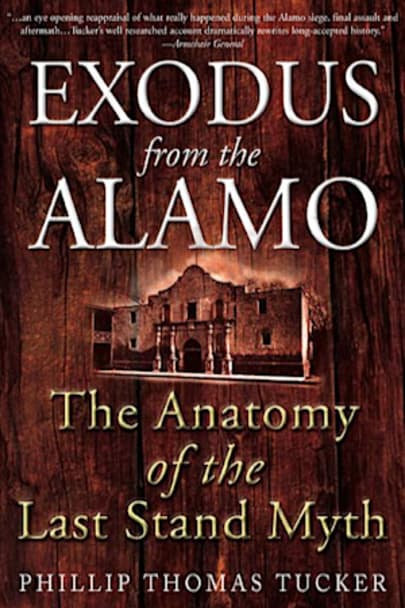The award-winning historian provides a provocative new analysis of the Battle of the Alamo–including new information on the fate of Davy Crockett. Contrary to legend, we now know that the defenders of the Alamo during the Texan Revolution died in a merciless predawn attack by Mexican soldiers. With extensive research into recently discovered Mexican accounts, as well as forensic evidence, … as forensic evidence, historian Phillip Tucker sheds new light on the famous battle, contending that the traditional myth is even more off-base than we thought.
In a startling revelation, Tucker uncovers that the primary fights took place on the plain outside the fort. While a number of the Alamo’s defenders hung on inside, most died while attempting to escape. Capt. Dickinson, with cannon atop the chapel, fired repeatedly into the throng of enemy cavalry until he was finally cut down. The controversy surrounding Davy Crockett still remains, though the recently authenticated diary of the Mexican Col. José Enrique de la Peña offers evidence that he surrendered.
Notoriously, Mexican Pres. Gen. Antonio López de Santa Anna burned the bodies of the Texans who had dared stand against him. As this book proves in thorough detail, the funeral pyres were well outside the fort–that is, where the two separate groups of escapees fell on the plain, rather than in the Alamo itself.
more



I don’t usually review nonfiction. However, I’m making an exception for Exodus from the Alamo: The Anatomy of the Last Stand Myth by Phillip Thomas Tucker (Ph.D. history, 1990).
First, because although I’ve long suspected we weren’t getting an entirely accurate story from our grade school history class, it never occurred to me that almost all of what we thought we knew was wrong. Wrong, or worse, outright lies.
I’ll hit the high points. The Alamo had no strategic value whatsoever and was indefensible. It had never been intended as a fort, it covered three acres, its perimeter wall was about one-quarter mile long and could not have been defended by the 182 men known to have been in the old mission. They were short of gunpowder, food and clothing—and had been before the thirteen day siege began. The majority of the defenders’ bodies were found outside the Alamo, as three separate groups broke out soon after the attack began. Tucker describes several acts of heroism by individuals but none of them had any hope of prevailing and none of them are the ones we hear about in the “legend” of the Alamo. And no, the Mexicans did not suffer thousands of casualties. Their losses were between two and three hundred, including wounded—and a number of those were likely from “friendly fire” in the pre-dawn attack.
And those are only the high points. To learn how this pointless effort was doomed from its conception, you’ll have to read the book. Every time I thought Tucker had revealed the worst failure by those in charge, I was mistaken. The words incompetent, ignorant, and undisciplined spring to mind.
My second reason for reviewing it is his glaring omission of a number of the Alamo’s inmates. Tucker presents convincing evidence of the survival of six or eight of the defenders and what became of them after the skirmish (General Santa Anna’s word). Yet he fails to mention approximately 20 women and children who were present and also survived. He was aware of them, as he quotes from an account one of them wrote later, and he mentions a woman who tended Bowie during his illness.
What, were they chopped liver? Oh, wait! It was 1836, so women ranked with lapdogs: no need to mention them. However, Tucker is a product of the late 20th century so his silence on the women’s survival seems odd. After the fighting ended (about 45 minutes after it began), Santa Anna issued each woman two silver dollars and a blanket to speed them on their way, one assumes.
Minor details: the first section of the book, dealing with the political background and motivations of the American influx into Texas, is not riveting. Once it moves on to the Alamo and the siege, it is fascinating and horrifying. For those interested in sources, Exodus from the Alamo’s notes and bibliography run to pages.
Better editing might have resulted in correction of some peculiar typographical errors, like “abode” instead of “adobe”, “rouges” instead of “rogues”, and “would of” instead of “would have”.
Even if you have no interest in 19th century America, military history or Texas, I recommend reading it. Ignorance is not bliss.